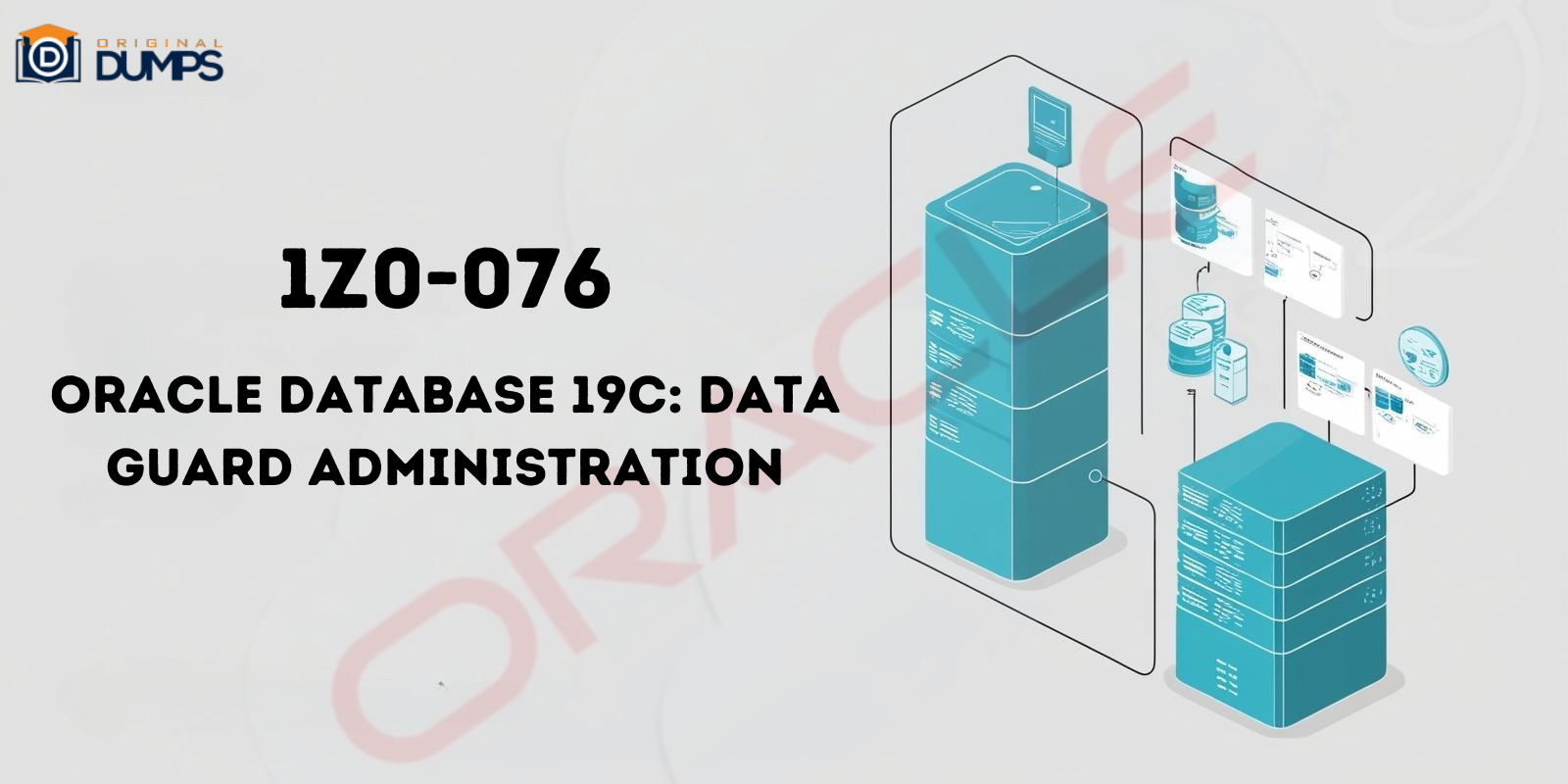If you're an IT professional looking to enhance your skills in Oracle Database 19c and improve your career prospects, the 1Z0-076 Oracle Database 19c: Data Guard Administration exam is the perfect way to demonstrate your expertise. This certification exam will test your knowledge of Oracle Data Guard—a tool essential for ensuring data availability and disaster recovery.
What’s the 1Z0-076 Oracle Database 19c: Data Guard Administration Exam About?
The 1Z0-076 exam is designed for database administrators who
want to prove their skills in managing Oracle Data Guard. Oracle Data Guard
ensures your databases are always available by creating standby databases that
can take over if the primary database fails. This exam evaluates your ability
to set up, monitor, and maintain Oracle Data Guard environments.
- By passing this exam, you’ll show that you can:
- Configure and manage Oracle Data Guard.
- Implement high-availability solutions.
- Perform routine Data Guard tasks.
- Handle failover, switchover, and data synchronization.
Key Areas You Need to Study for Success
The 1Z0-076 exam covers several critical topics related to
Oracle Data Guard. Let’s break them down into manageable sections:
1. Oracle Data Guard Architecture and Components
- Learn the various parts that make up Data Guard, such as
primary databases, standby databases, and Data Guard brokers.
- Understand how these components work together to ensure data protection and recovery.
2. Setting Up and Configuring Data Guard
- Master the steps for setting up Oracle Data Guard
environments.
- Explore how to configure primary and standby databases using the Data Guard broker and command-line tools.
3. Data Guard Monitoring and Maintenance
- Discover how to monitor your Data Guard system using tools
like Oracle Enterprise Manager (OEM) and other monitoring options.
- Learn how to perform essential tasks like managing redo logs, performing failovers, and applying patches.
4. Data Guard Security and Optimization
- Understand how to secure your Data Guard setup by
configuring safe communication and encryption between primary and standby
databases.
- Learn how to optimize your Data Guard environment for better performance and reliability.
5. Troubleshooting Data Guard Issues
- Get familiar with common problems that may arise in Data
Guard configurations, such as synchronization delays or standby database
issues.
- Know how to troubleshoot and fix these problems effectively to ensure smooth operations.
High Availability with Oracle Data Guard: What You Need to Know for 1Z0-076
One of the most critical aspects of Oracle Data Guard is its
role in providing high availability and disaster recovery solutions. This
functionality is essential for the 1Z0-076
exam.
Oracle Data Guard ensures that your databases remain available even during planned or unplanned outages by maintaining standby databases that can quickly take over as the primary. Key concepts to focus on include:
- Real-time data protection: Data Guard provides
real-time data protection by maintaining synchronized copies of the primary
database.
- Automatic failover: This minimizes downtime by
automatically switching to a standby database when a failure occurs.
- Disaster recovery: In case of a disaster at the
primary site, the standby databases can take over seamlessly, ensuring business
continuity.
Focusing on these features during your preparation will help you understand the core value of Data Guard in maintaining system uptime and reliability.
Understanding Oracle Data Guard Broker: A Comprehensive Guide
Oracle Data Guard Broker automates and simplifies the
management of Data Guard configurations. For the 1Z0-076 exam, you’ll need a
comprehensive understanding of how this tool works.
Key Features:
- Automatic configuration management: Data Guard Broker
automates the setup of both primary and standby databases.
- Failover and switchover management: The Broker
handles failover and switchover operations automatically based on system health
or administrator commands.
- Monitoring and reporting: It provides real-time
monitoring of the Data Guard configuration, offering alerts and status reports
for all connected databases.
Mastering the Data Guard Broker will be crucial for managing your Oracle environments efficiently and ensuring high availability with minimal manual intervention.
Common Issues in Data Guard Setup and How to Resolve Them
When configuring Oracle Data Guard, administrators often
face challenges. Understanding these common issues and knowing how to
troubleshoot them will help you confidently manage your Data Guard setups.
Common Issues:
1. Data Synchronization Delays: If the primary and standby
databases are not in sync, the system may fail to apply redo logs promptly.
- Solution: Check network latency, redo log configurations,
and ensure that both databases are configured with proper I/O settings.
2. Failure in Log Transport: Logs may fail to transport from
the primary database to the standby database due to incorrect configurations.
- Solution: Verify log transport services, check for errors in
the alert logs, and ensure proper permissions and network connectivity.
3. Role Transitions: When switching roles, the primary may
fail to handover to the standby database.
- Solution: Ensure proper role transition scripts are used, check Data Guard Broker settings, and monitor network stability.
Backup and Recovery Strategies in Oracle Data Guard: Best Practices for 1Z0-076
Oracle Data Guard plays a crucial role in backup and
recovery, but understanding best practices specific to Data Guard is vital for
the 1Z0-076 exam.
Best Practices:
- Use of Redo Logs: Ensure that all redo logs from the
primary database are transmitted and applied to the standby databases for
proper data synchronization.
- Backup Strategy: Schedule backups on the standby
database to offload the backup process from the primary, ensuring that backup
procedures do not impact primary database performance.
- Archived Log Management: Retain archived logs on both primary and standby databases for recovery operations. Ensure they are backed up regularly.
Automating Data Guard Failover and Switchover: Tools and Techniques
One of the most critical aspects of Oracle Certification is the
ability to automatically manage failovers and switchovers. This minimizes
downtime during system maintenance or when failures occur.
Tools and Techniques:
- Data Guard Broker: Automates both failover and switchover
processes.
- Fast-Start Failover (FSFO): Allows Data Guard to
automatically failover to a standby database in case of primary database
failure with minimal delay.
- Role Transition with DGMGRL: Use the Data Guard command-line interface (DGMGRL) to automate role transitions, including failover and switchover.
Conclusion:
Earning the 1Z0-076 Oracle Database 19c: Data Guard
Administration certification can open up exciting career opportunities in
database management. With the skills and knowledge you’ll gain from passing
this exam, you’ll be ready to manage Oracle Data Guard systems and help your
organization safeguard its critical data.
Start preparing today with OriginalDumps and take advantage of our comprehensive study materials, practice tests, and expert insights. Our resources are designed to help you succeed, just like the best practice materials and Oracle certification dumps available for your preparation. Make sure to utilize 1Z0-076 exam dumps and other valuable Oracle exam dumps to optimize your study plan.






